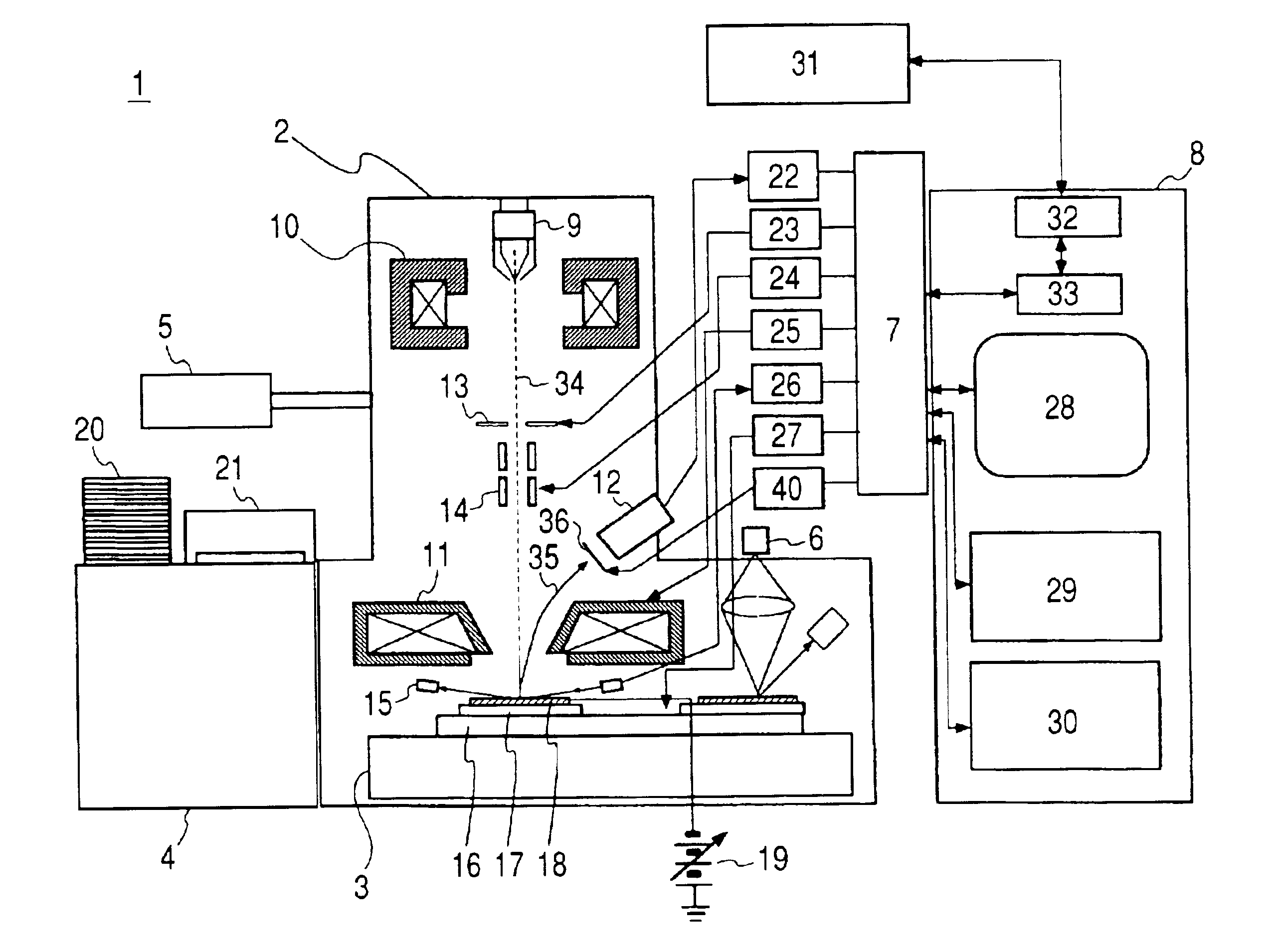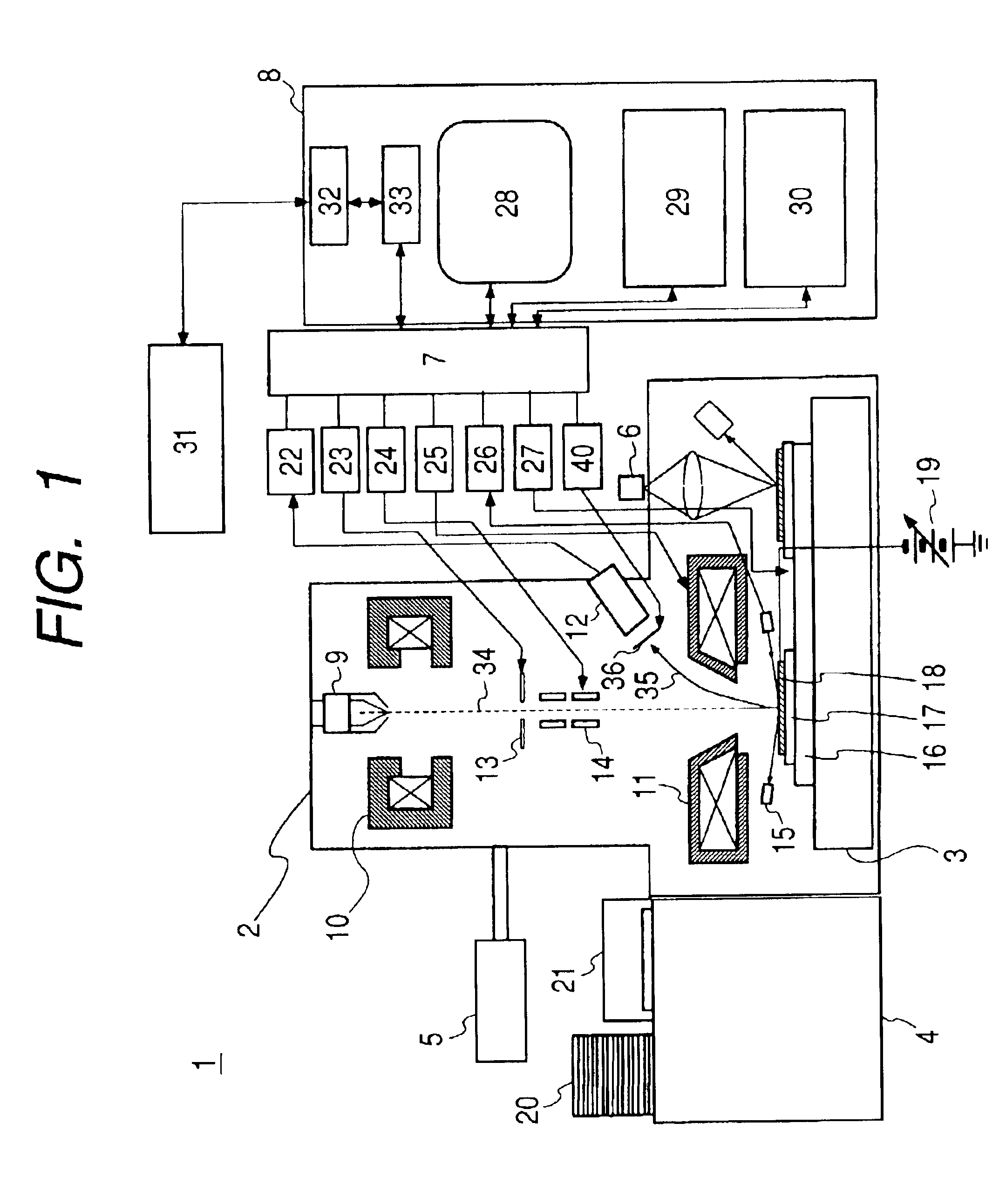Wafer inspection method of charging wafer with a charged particle beam then measuring electric properties thereof, and inspection device based thereon
a technology of charged particle beam and inspection method, which is applied in the direction of individual semiconductor device testing, semiconductor/solid-state device testing/measurement, instruments, etc., can solve the problems of inaccurate measurement, difficult measurement, and unrealistic approach, and achieve the effect of changing the charge voltag
- Summary
- Abstract
- Description
- Claims
- Application Information
AI Technical Summary
Benefits of technology
Problems solved by technology
Method used
Image
Examples
embodiment 1
[0050
[0051]This embodiment refers to a method by which the resistance-voltage characteristics of a sample are quickly measured in a non-contact manner so as to identify the types of defects. FIG. 7 shows a cross section of the wafer used here. It consists of a Si substrate 701, a SiO2 film 702, via (or contact) holes with an embedded poly-silicon plug 703, n-diffusion layers 704 beneath the via (or contact) holes, and PN junctions 706 formed by the diffusion layers 704. It also has an incomplete contact defect 705.
[0052]FIG. 1 shows the structure of a semiconductor device inspection device according to this embodiment. The semiconductor device inspection device 1 is mainly composed of an electron optics system 2 (i.e., an inspection chamber), a stage mechanism 3, a wafer transportation system 4, an evacuation system 5, an optical microscope 6, a control system 7 and a control section 8.
[0053]The electron optics system 2 consists of an electron gun 9 for emitting an electron beam 34,...
embodiment 2
[0071
[0072]According to the second embodiment, the resistance of each electronic device at a desired charged voltage is measured using the inspection device according to the first embodiment. If the measured resistance value is different from a predetermined value, the part in question is regarded as a defect, and the position of that defective part is displayed. The charged voltage control is performed as follows. The information on the charged voltage measured using the energy filter 36 is sent to the computing section 29 where the electron beam irradiation conditions for attaining the desired charged voltage are determined. This information is sent to the control system 7. If the desired charged voltage is not attained due to a failure in properly setting electron beam irradiation conditions, the same procedure is repeated. A detailed description of the inspection device is omitted here as the device is detailed in the explanation of the first embodiment.
[0073]This procedure can ...
embodiment 3
[0074
[0075]According to the third embodiment, we conducted an inspection of PN junctions of a CMOS formed on a wafer using the inspection device according to the first embodiment. By measuring the resistance-voltage characteristics, we could identify the orientation of PN junctions, incomplete contact defects, and leakage defects. The inspection results are shown in FIG. 12. Here, numeral 1201 designates a PN junction in which the wafer surface is an n-diffusion layer. Numeral 1202 designates a PN junction in which the wafer surface is a p-diffusion layer. Numeral 1203 designates an incomplete contact defect, and numeral 1204 designates a leakage defect. Furthermore, when inspection conditions which do not cause a breakdown are maintained by controlling the charged voltage, a judgment of inspection results can be made simply by checking variations in voltage contrast image signals (NVC and PVC). The results are shown in FIG. 13.
PUM
| Property | Measurement | Unit |
|---|---|---|
| charged voltages | aaaaa | aaaaa |
| charged voltages | aaaaa | aaaaa |
| charged voltages | aaaaa | aaaaa |
Abstract
Description
Claims
Application Information
 Login to View More
Login to View More - R&D
- Intellectual Property
- Life Sciences
- Materials
- Tech Scout
- Unparalleled Data Quality
- Higher Quality Content
- 60% Fewer Hallucinations
Browse by: Latest US Patents, China's latest patents, Technical Efficacy Thesaurus, Application Domain, Technology Topic, Popular Technical Reports.
© 2025 PatSnap. All rights reserved.Legal|Privacy policy|Modern Slavery Act Transparency Statement|Sitemap|About US| Contact US: help@patsnap.com



